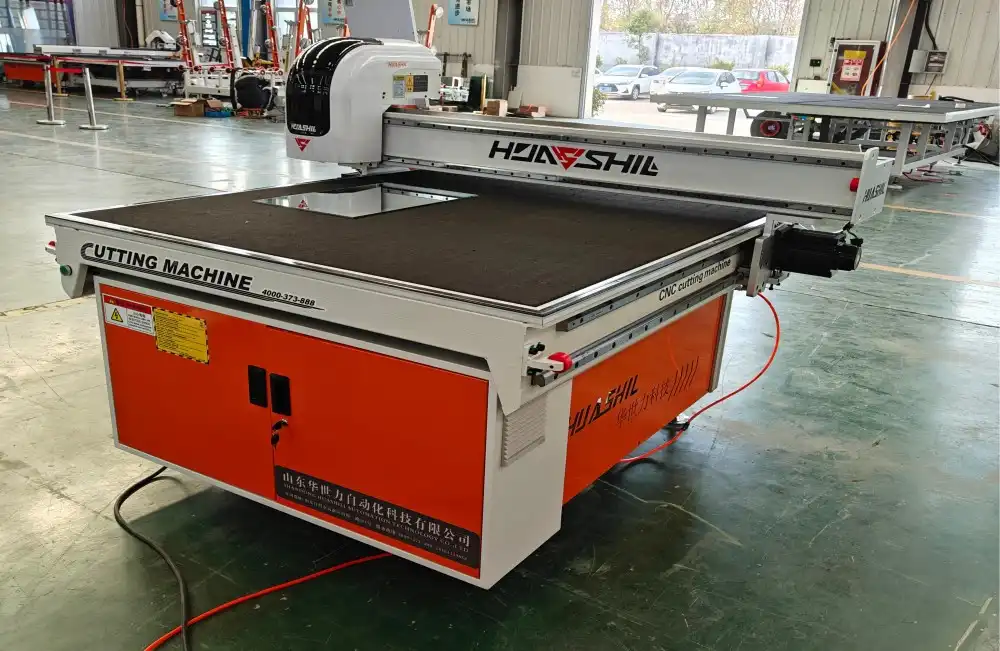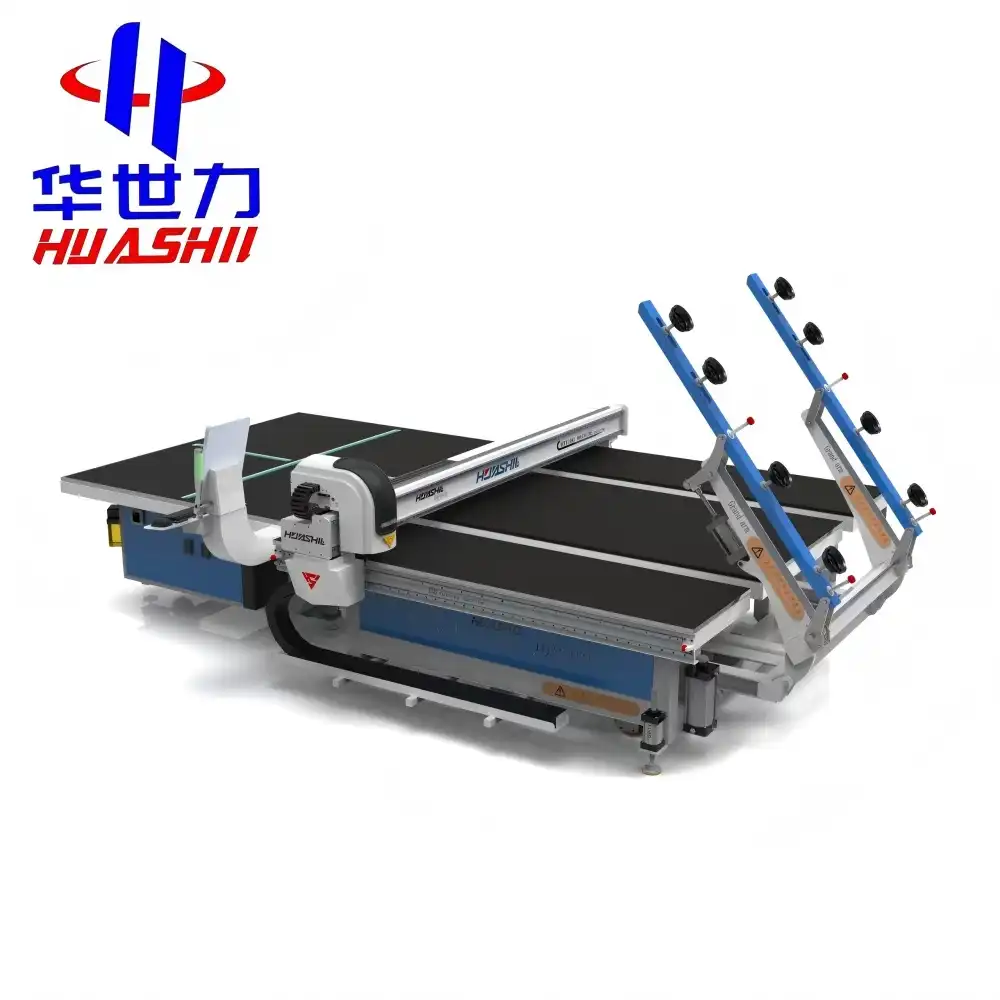In the world of furniture manufacturing, precision and safety go hand in hand. When it comes to working with furniture cabinet glass cutting machines, understanding and implementing proper safety measures is paramount. This comprehensive guide will explore the critical safety features, best practices for maintaining a secure working environment, and essential protective gear requirements for operating glass cutting machinery.
Critical safety features every glass cutting machine should have
Modern furniture cabinet glass cutting machines are equipped with a variety of safety features designed to protect operators and ensure smooth, secure operations. Let's delve into some of the most crucial safety elements:
Automatic shut-off mechanisms
One of the primary safety features in any glass cutting machine is an automatic shut-off system. This mechanism instantly halts machine operation when it detects potential hazards, such as unexpected obstructions or operator errors. The rapid response time of these systems can prevent serious accidents and minimize damage to both the equipment and materials.
Protective guards and enclosures
High-quality glass cutting machines incorporate robust protective guards and enclosures. These physical barriers shield operators from flying glass shards, debris, and moving parts. Properly designed guards should allow for easy visibility of the cutting process while maintaining a safe distance between the operator and potential hazards.
Precision alignment systems
Accurate alignment is crucial not only for achieving precise cuts but also for ensuring safety during operation. Advanced alignment systems, often utilizing laser technology, help operators position glass sheets correctly, reducing the risk of misalignment-related accidents and improving overall cutting efficiency.

Dust extraction and ventilation
Glass cutting processes with a furniture cabinet glass cutting machine made in China generate fine particles that can be harmful if inhaled. Effective dust extraction and ventilation systems are essential for maintaining a clean and safe working environment. These systems should be designed to capture and remove airborne particles efficiently, protecting operators from respiratory hazards.
Non-slip surfaces and ergonomic design
The overall design of the machine plays a significant role in operator safety. Non-slip surfaces on work areas and control panels help prevent accidents caused by slipping or loss of grip. Additionally, ergonomic design features, such as adjustable height controls and easily accessible emergency stop buttons, contribute to operator comfort and reduce the risk of fatigue-related errors.
Maintaining a safe working environment with glass processing
Beyond the machine's built-in safety features, maintaining a safe working environment is crucial when operating furniture cabinet glass cutting machines. Here are some key considerations for creating and maintaining a secure workspace:
Proper training and certification
Comprehensive training is the foundation of a safe working environment. All operators should receive thorough instruction on machine operation, safety protocols, and emergency procedures. Regular refresher courses and updated certifications ensure that operators remain knowledgeable about the latest safety practices and machine features.
Clear workspace organization
A well-organized workspace is essential for safe glass cutting operations. Implement a system for storing glass sheets, tools, and equipment that minimizes the risk of accidents. Clearly marked pathways and designated work areas help prevent collisions and ensure smooth workflow.
Regular equipment maintenance
Adhering to a strict maintenance schedule is crucial for the safe and efficient operation of glass cutting machines. Regular inspections, cleaning, and servicing help identify potential issues before they become safety hazards. Keep detailed maintenance logs and promptly address any concerns raised during inspections.

Proper material handling
Safe handling of glass sheets is critical to prevent injuries and damage. Implement proper lifting techniques and utilize appropriate handling equipment, such as a furniture cabinet glass cutting machine, vacuum lifters, or mechanical assists, to move heavy or large glass panels. Ensure that all handling equipment is regularly inspected and maintained to prevent failures during use.
Environmental controls
Maintaining optimal environmental conditions in the workspace contributes to both safety and product quality. Control factors such as temperature, humidity, and lighting to create a comfortable and safe working environment. Proper lighting is particularly important for accurate glass cutting and reducing eye strain.
Emergency stop systems and protective gear requirements
When it comes to operating furniture cabinet glass cutting machines, having robust emergency stop systems and appropriate protective gear is non-negotiable. Let's explore these critical safety elements in detail:
Emergency stop systems
Emergency stop systems are the last line of defense against accidents and should be designed for immediate and foolproof activation. Key features of effective emergency stop systems include:
- Easily accessible emergency stop buttons located at strategic points around the machine
- Clear, visible labeling of all emergency stop controls
- Redundant systems to ensure fail-safe operation
- Regular testing and maintenance of emergency stop mechanisms
- Integration with other safety systems for comprehensive machine shutdown
Operators should be trained to locate and activate emergency stops instinctively, even in high-stress situations. Regular drills can help reinforce this critical skill.
Personal protective equipment (PPE)
Proper protective gear is essential for anyone working with or around glass cutting machines. The following PPE should be mandatory for all operators and nearby personnel:
- Safety glasses or goggles: To protect eyes from glass particles and debris
- Cut-resistant gloves: To prevent cuts and lacerations when handling glass
- Steel-toed boots: To protect feet from falling glass sheets or heavy equipment
- Protective clothing: Long-sleeved shirts and pants to minimize skin exposure
- Dust masks or respirators: To prevent inhalation of glass particles and dust
- Hearing protection: If noise levels exceed safe limits
It's crucial to ensure that all PPE fits properly and is in good condition. Regular inspections and replacements of worn or damaged equipment should be part of standard safety protocols.
Safety signage and communication
Clear and prominent safety signage plays a vital role in maintaining a safe working environment. Implement a comprehensive system of signs and labels that:
- Clearly mark hazardous areas and equipment
- Provide instructions for proper machine operation and safety procedures
- Indicate the location of emergency equipment and exits
- Remind workers of PPE requirements in different areas

In addition to visual cues, establish clear communication protocols for reporting safety concerns, near-misses, and accidents with a furniture cabinet glass cutting machine made in China. Encourage a culture of open communication where workers feel comfortable discussing safety issues without fear of repercussions.
Regular safety audits and improvements
To ensure ongoing safety in glass cutting operations, implement a system of regular safety audits. These audits should:
- Evaluate the effectiveness of current safety measures
- Identify potential hazards or areas for improvement
- Review accident reports and near-misses to prevent future occurrences
- Assess compliance with industry standards and regulations
- Gather feedback from operators on safety concerns and improvement suggestions
Use the insights gained from these audits to continuously refine and enhance your safety protocols. Stay informed about advancements in safety technology and best practices in the industry to ensure your operations remain at the forefront of workplace safety.
Training for emergency situations
While prevention is key, being prepared for emergencies is equally important. Develop and implement comprehensive emergency response plans that cover various scenarios, such as:
- Machine malfunctions and unexpected shutdowns
- Fires or electrical emergencies
- Serious injuries or medical emergencies
- Chemical spills or hazardous material exposure
Conduct regular drills and simulations to ensure all personnel are familiar with emergency procedures and can respond effectively under pressure. This preparation can make a critical difference in minimizing the impact of unexpected events.
Ergonomic considerations
While often overlooked, ergonomic factors play a significant role in operator safety and well-being. Proper ergonomics can prevent repetitive strain injuries, reduce fatigue, and improve overall productivity. Consider the following ergonomic elements when setting up and operating glass cutting machines:
- Adjustable workstations to accommodate operators of different heights
- Anti-fatigue mats to reduce strain during prolonged standing
- Ergonomically designed controls and interfaces for comfortable operation
- Proper lighting to reduce eye strain and improve visibility
- Regular breaks and job rotation to prevent repetitive stress injuries
Implementing these ergonomic considerations not only enhances safety but also contributes to increased job satisfaction and long-term operator health.
Continuous improvement and innovation
The field of industrial safety is constantly evolving, with new technologies and methodologies emerging regularly. Stay proactive in your approach to safety by:
- Keeping abreast of the latest safety innovations in glass cutting machinery
- Participating in industry forums and conferences focused on workplace safety
- Collaborating with machine manufacturers to provide feedback and suggestions for safety improvements
- Encouraging operators to share ideas for enhancing safety in their daily work
By fostering a culture of continuous improvement and innovation in safety practices, you can create a work environment that not only meets but exceeds industry standards for safety and efficiency.

Conclusion
Implementing comprehensive safety measures for furniture cabinet glass cutting machines is crucial for protecting workers, maintaining productivity, and ensuring the longevity of your equipment. By focusing on machine safety features, maintaining a secure working environment, and prioritizing emergency preparedness and protective gear, you can create a workplace that values safety as much as it does quality and efficiency.
At Shandong Huashil Automation Technology Co., LTD, we understand the importance of safety in glass cutting operations. Our advanced furniture cabinet glass cutting machine made in China are designed with state-of-the-art safety features, ensuring that your operations meet the highest standards of workplace safety. With years of experience in automated R&D, manufacturing, and sales of mechanical equipment, we're committed to providing our global customers with cutting-edge solutions that prioritize both performance and safety.
Ready to elevate your glass cutting operations with machinery that puts safety first? Contact our expert team today at salescathy@sdhuashil.com to learn more about our advanced glass cutting solutions and how they can transform your production process. Let's work together to create a safer, more efficient future for your glass cutting operations.
References
1. Smith, J. (2022). "Occupational Safety in Glass Manufacturing: A Comprehensive Guide." Journal of Industrial Safety, 45(3), 112-128.
2. Johnson, A. & Lee, S. (2021). "Advancements in Safety Technologies for Automated Glass Cutting Machinery." International Conference on Industrial Automation and Safety Proceedings, 78-92.
3. National Glass Association. (2023). "Best Practices for Glass Handling and Processing Safety." 4th Edition. Glass Industry Safety Council Publications.
4. Zhang, L. et al. (2020). "Ergonomic Considerations in Glass Cutting Workstations: A Case Study Analysis." Applied Ergonomics, 89, 103-115.



